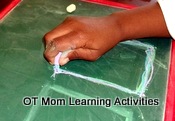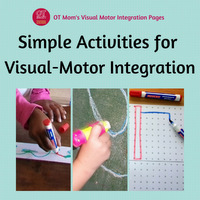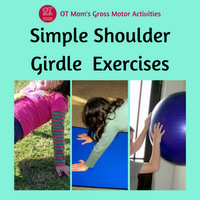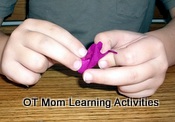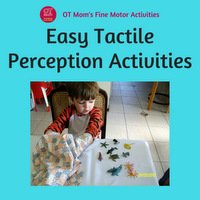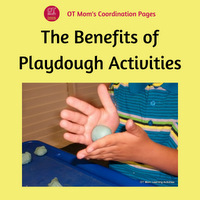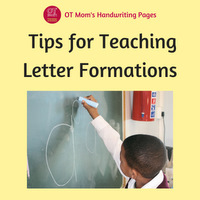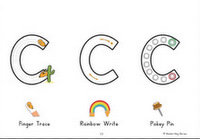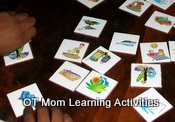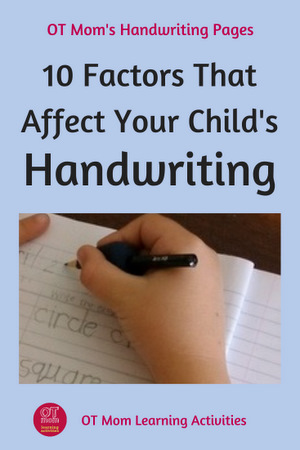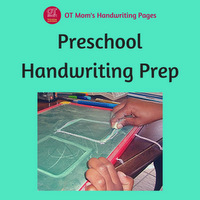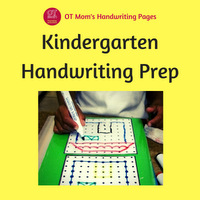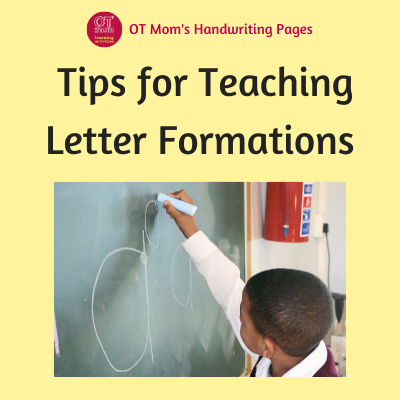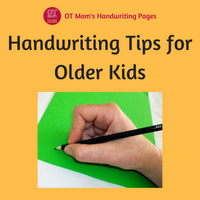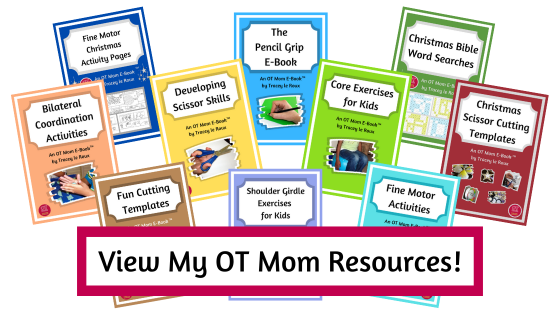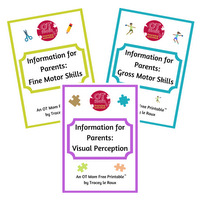- Home Page
- Handwriting for Kids
- Factors Affecting Handwriting Skills
Factors Affecting Handwriting
Understand What Causes Poor Handwriting
There are many factors affecting handwriting skills.
If you want to know how to improve your child’s handwriting, you may need to take a step back and look at the underlying skills that a child needs for good handwriting. If your child struggles with fine motor skills, perception skills or coordination skills, all of these could have an influence on their handwriting.
On this page I take a look at 10 different factors affecting handwriting - some of these may be familiar concepts to you, some may be unfamiliar. I give a brief overview of the underlying skill, and then I’ll give you some ways you can help your child develop that skill with the free activities and tips on my website.
I sometimes link to products (#Ad) that are similar to those I use and love. If you do purchase something through my links, I will receive a small commission that helps support my site - thank you!
However, if you are concerned that your child’s poor handwriting is affecting performance at school, please do consult an occupational therapist for an evaluation - this page is meant to promote your child’s optimal development and is not intended to diagnose or treat any disorders.
- Visual-Motor Integration and Handwriting
- Fine Motor Skills and Handwriting
- Eye-Hand Coordination and Handwriting
- Spatial Perception and Handwriting
- Directionality, Letter Reversals and Handwriting
- Sensory Feedback and Handwriting
- Orthographic Coding and Handwriting
- Visual Perceptual Skills and Handwriting
- Motor Planning Skills and Handwriting
- Organization, Problem Solving and Handwriting
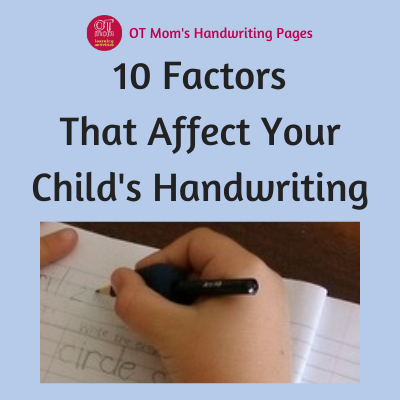
1) Visual-Motor Integration (VMI) and Handwriting
Visual-motor integration and specific fine motor skills have found by various studies to be the most important factors affecting handwriting ability (see references).
Visual-Motor Integration (VMI) enables the hands to correctly replicate what the eyes see.This enables a child to be able to accurately copy numbers, and letters.
Preschool children need lots of practice in tracing and copying basic shapes such as diagonal lines, circles, squares, triangles and intersecting lines.
This is an important foundation before learning number and letter formations.
How You Can Help Your Child Develop Visual-Motor Integration Skills
- Provide lots of opportunities to trace and draw shapes and simple drawings in early childhood BEFORE letters are introduced.
- Let your child trace over your shapes in sand, or with chalk on a board before trying to draw the shapes on their own.
- Older kids can benefit from copying grid drawings to strengthen their visual motor skills.
- Check out my visual-motor integration activities for kids of all ages.
2) Fine Motor Skills and Handwriting
People often think that the child's pencil grip affects handwriting. However, the actual position of the fingers on the pencil could be less important than we think.
Finger movements and in-hand manipulation skills are the important fine motor factors affecting handwriting (see references).
A poor sitting posture will also affect handwriting in kids, as the smaller muscles of the hands are not freed up to work properly when the body is not sitting in a good position!
How You Can Help Your Child Develop Fine Motor Skills for Handwriting
- Encourage your child to spend less time on electronic devices and more time on gross motor and fine motor activities to build these skills. Swiping a screen does not help develop the in-hand manipulation and finger skills that are needed for handwriting!
- Work on core muscles and shoulder muscles so that the hands and fingers will be able to move more freely and accurately.
- Climbing on jungle gyms gives these muscles a good workout - encourage your child to climb and clamber as much as possible.
- Work on hand and finger skills from an early age.
- Encourage lots of scissor cutting, playdough play and playing with lego.
For a wealth of accessible fine motor ideas at your fingertips, check out my printable fine motor downloads!
3) Eye-Hand Coordination and Handwriting
Children need eye-hand coordination to guide their pencil between the lines and ensure their letters don’t go over the lines or touch each other.
Eye-hand coordination is therefore an important factor in developing neat handwriting.
How You Can Help Your Child Develop Eye-Hand Coordination Skills
- Help your child develop this skill with lots of eye-hand coordination activities.
- Play
bean bag games, ball tossing games, and bat and ball games as much as
possible.
- Encourage your child to thread beads and do lacing cards. Playing with Lego and other types of building blocks also encourages eye-hand coordination. You can get ideas for simple activities for young kids here.
- Look for worksheets and activity books that have mazes and follow-the-path pictures. Working on ocular motor skills such as visual tracking can also help develop hand-eye coordination skills.
4) Spatial Perception and Handwriting
Spatial perceptual skills help kids to lay their work out neatly on the page, and to size and space their letters and words correctly.
When spatial perception is poor, then their handwriting may look messy because of the irregularly sized letters, and the haphazard spacing of work on the page. This is common in children who are still learning to write, but may signify a problem by the second and third grade.
How You Can Help Your Child Develop Spatial Perception Skills
- Encourage your child to play with spatial perceptual puzzles like Pattern Blocks#Ad and Tangrams#Ad.
- The biggest spatial perception challenge comes from filling in a shape without any internal lines to tell you what shape to use.
You can download a free PDF from Young Mathematicians, that will give you pattern block outlines like the giraffe alongside, to help challenge your child.
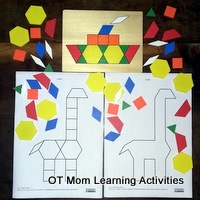 Pattern Blocks
Pattern Blocks- Construction games where your child needs to follow instructions,such as building LEGO models#Ad, are also great for building spatial perceptual skills.
- Older children may need to learn compensatory strategies
to help them with handwriting. These may include specially lined paper,
sticks to help with spacing on the page and frequent cueing.
5) Directionality, Reversals and Handwriting
One of the factors affecting handwriting is whether the child can consistently work from left to right, and whether words are written in the right direction.
Directionality and problems with left-right discrimination can affect letter reversals and transcription (writing "saw" as "was").
Starting on the wrong side of the page or writing in the wrong direction is affected by poor directionality skills as well as avoiding crossing the midline.
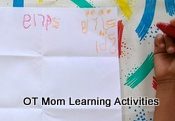 Poor directionality
Poor directionalityHow You Can Help Your Child Develop A Good Sense of Directionality
- Help your child get a good sense of direction with games that use space, and space words, such as forwards, backwards, up and down, under and over.
- Work on midline crossing with some fun activities that get your child reaching over to the opposite side of the body with each hand.
- Once general space concepts are established, play some games using left and right. This can take some time for your child to master, so be patient!
6) Sensory Feedback and Handwriting
Getting good tactile (touch) feedback, as well as proprioceptive and kinesthetic feedback from the hands and joints plays an important role in helping develop good handwriting for kids.
Kids who have poor sensory feedback from their hands may hold the pencil too tightly, or press too hard on the paper when writing.
Sometimes they may scribble "uncontrollably" to give themselves the extra sensory feedback that they crave, much to the frustration of their teacher!
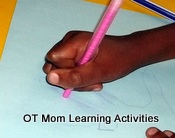 Holding too tightly and pressing too hard
Holding too tightly and pressing too hard
They may also feel the need to keep their heads close to their work to
watch while they write, trying to get as much visual feedback as
possible to compensate for their poor sensory input.
How You Can Help Boost Your Child's Sensory Processing Skills
- Try some tactile discrimination activities
to help develop good touch perception.
Hide some toy animals in a cloth bag and have your child identify the animal by feel. You can also use regular household objects for younger kids.
- Playing with playdough
can give the hands lots of proprioceptive feedback.
Make a big batch of lovely homemade playdough, and encourage your child to knead, pound, and pull off blobs of playdough to give the hands a good workout.
For more information, please read my article on sensory processing.
7) Orthographic Coding and Handwriting
Orthographic coding skills enable a child to remember what a word or letter looks like, and then to write it down as needed.
Children with poor orthographic coding skills easily forget how a letter is formed and may thus form it differently each time they write it, even writing it different ways within the same writing task!
Or they may retrace parts of the letter trying to figure out where the next part goes. This is an important factor contributing to untidy handwriting.
Kids with poor orthographic coding may struggle to figure out where to start the letter, and may hesitate a lot while writing.
They take a long time to put their thoughts on the page as they are just trying to figure out where to start to form the letters or how to write the word.
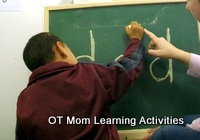 Working on letter formation
Working on letter formation
Orthographic coding delays may therefore affect reading and spelling as well as being one of the factors affecting handwriting skills.
How You Can Help Your Child Develop Orthographic Coding Skills
(these suggestions deal only with the handwriting aspect of orthographic coding)
- Teaching correct letter formations from an early age
may help reduce later problems with handwriting. Start with the letters of your child's
name. It is never too early to learn to form the letters correctly! Handwriting Heroes#Ad have a tried and tested method of helping kids master the correct formations from the beginning!
- Just as you would encourage your child to practice kicking a ball or building a tower, show the same patience and creativity in practicing letters correctly.
Make it fun and interesting, but don't force young kids to write if they are not interested. Try these fun letter formation activities, or check out my tips and strategies for kids who are struggling.
- Use verbal cues (such as rhymes that reinforce the formation of the letters). Look for programs like Handwriting Heroes#Ad that use rhymes, stories and animations to help kids master letter formations.
- You can also work on visual memory skills with games like Concentration and include memory exercises in letter formations as well. Have them look at a letter, trace it with a finger, cover it up, picture it in their mind’s eye, trace it in the air and then check, trace it again and then write.
- Ask your child to try writing the letter in the air with eyes closed. Watch carefully and you will get a good sense of whether the correct formation has been internalized.
- Older kids may benefit from a letter chart on their desk, along with arrows indicating starting point and initial direction.
8) Visual Perceptual Skills and Handwriting
Visual perception enables kids to understand what they see. The different visual perceptual skills are all factors affecting handwriting in different ways.
Here are some examples:
A child with poor visual discrimination skills may not see that an “r” is different to an “n” or an “h”. And this may be reflected in a child's handwriting, where those letters all look the same!
A child with poor visual closure skills may not realize that an “o” which is not closed properly looks like “u”, and this would affect the neatness and legibility of their handwriting.
How You Can Help Your Child Develop Visual Perception Skills
- Encourage your child to pay attention visually by finding items
in picture books, finding specific groceries on a shopping
advertisement, and looking at "spot the difference" pictures.
- Look out for Lotto and Bingo type games where your child needs to match up picture cards.
- Incorporate visual perceptual games and activities into your family life. Try "Seek and Find" books and plan regular jigsaw puzzle sessions as a family. Check out my visual perception suggestions for older kids!
9) Motor Planning Skills and Handwriting
Motor planning is one of many factors that affect how a child develops handwriting skills:
- figuring out how to hold the pencil and how to put it to paper
- planning the layout of work on the page and carrying it out
- establishing the motor memory of remembering how letters are formed
- carrying over the memory from one task to the next
When kids have poor motor planning skills, a handwriting lesson is like a brand new lesson for them each time – they may really struggle to carry over what they have learned in previous lessons.
You may also see the child with poor motor planning skills struggling with other classroom tasks, like figuring out how to use a ruler to draw a line, figuring out how to cut around a complex shape with scissors, etc. even if they have done the task before.
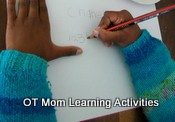 Planning how and where to write
Planning how and where to writePoor motor planning (also called dyspraxia) can thus affect all the other areas discussed here (such as fine motor skills, visual motor coordination, orthographic coding, etc)
How You Can Help Your Child Develop Motor Planning Skills
- Kids with poor motor planning skills can benefit from lots of sensory and movement input to help their brains develop sensory-motor maps of movements.
- They also benefit from learning strategy through games such as obstacle courses and strategic board games like Catan#Ad or Rush Hour #Ad– they may need to be patiently taught the strategies of each game.
- However, in the classroom, these children may need specific accommodations to help them work around their problems. An occupational therapist will help analyze your child's specific challenges and then provide "just right" recommendations to help your child.
10) Organization, Problem Solving and Handwriting
Organization and problem solving skills include motor planning and the spatial perceptual ability to lay work out well on the page.
The resulting general disorganization and failure to understand and follow instructions, are factors affecting handwriting output.
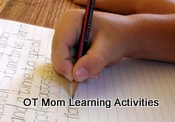
How You Can Help Your Child Develop Organization and Problem Solving Skills
How You Can Help:
- Play listen-and-do games, where your child has to respond to instructions given.
- Young kids love to help in the kitchen, so baking and cooking with them is an ideal way to help them learn to follow instructions!
- Problem solving games such as Rush Hour#Ad as well as spatial perceptual games such as Tangrams#Ad, can help a child develop organization and problem solving skills.
- Board games such as Catan#Ad, Ticket to Ride#Ad and other similar games, can help your older child learn to plan and strategize. (Try the shorter Ticket to Ride games#Ad if your child isn't ready for long board games yet. For a younger child, try Junior Catan#Ad, or Junior Ticket to Ride#Ad)
I hope you found this page useful in helping you to understand the variety of different factors affecting handwriting and how you can help your child to develop a strong foundation for this crucial skill!
Please sign up for my occasional newsletter to stay in touch with new pages on my site!
- Home Page
- Handwriting for Kids
- Factors Affecting Handwriting Skills
Share this page to help others!
Related Handwriting Pages On My Site
References: Factors Affecting Handwriting
- Cornhill, H; Case-Smith, J. Factors That Relate to Good and Poor Handwriting. 50(9):732-9 · November 1996 http://dx.doi.org/10.5014/ajot.50.9.732
- Daly, C.J., Kelley, G.T., Krauss, A. Relationship between visual-motor integrations and handwriting skills of children in kindergarten: a modified replication study.” AJOT, 2003, 57(4):459-642. http://dx.doi.org/10.5014/ajot.57.4.459
- Dinehart, L. Handwriting in early childhood education: Current research and future implications Journal of Early Childhood Literacy · March 2014 http://dx.doi.org/10.1177/1468798414522825
- Kaiser, M-L; Albaret, J-M; and Doudin P-A. Relationship Between Visual-Motor Integration, Eye-Hand Coordination, and Quality of Handwriting, Journal of Occupational Therapy Schools & Early Intervention 2(2):87-95 · April 2009. DOI: 10.1080/19411240903146228
- Tennyson, J. Effective Occupational Therapy Intervention For Handwriting/Fine Motor Difficulties, Master's Thesis, Humboldt Stae University, 2006. Article can be viewed here.
- Weintraub, N. ;Graham, S. The contribution of gender, orthographic, finger function, and visual-motor processes to the prediction of handwriting status. The Occupational Therapy Journal of Research; 20(2):121-140 · March 2000 http://dx.doi.org/10.1177/153944920002000203
Didn't find what you were looking for? Try a search of my site!
